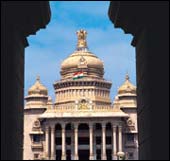 |
 |
 |
 |
 |
| From top: The seat of power—the
Vidhan soudha; a booming city; the Outer Ring Road; a city on
the move, and a bustling foodcourt |
On
the day in July his company declares its not-so-flattering results
for the April-June quarter Wipro Ltd. Chairman Azim Premji, a patrician
57-year-old with an unruly white mane, decides he has had enough.
Wipro's corporate office is in Sarjapur, a Bangalore borough that
has stayed off the radar of city departments, athough a proposed
it corridor linking Electronics City in the south of the city to
Whitefield in the north should change that. The road to Wipro's
office is bad, accidents are commonplace, and on this particular
day the telephones are down-reason enough for the usually placid
Premji to launch a broadside at the state government.
Bangalore, a city of six million that has emerged
the hub of knowledge-businesses in India, is a mess. Brown-outs
are a way of life, parts of the city suffer from water shortage,
and peak-time commuting is torturous, if not downright hazardous.
Delhi has better roads, Mumbai, a more reliable power-supply, and
Chennai has made some faltering progress towards installing a city-wide
Mass Rapid Transit System (an elevated railway), a process that
is stuck somewhere in the government-works in Bangalore.
A few hours before Premji's offensive, Karnataka
Chief Minister S.M. Krishna meets with Nandan Nilekani, the CEO
of the city's best-known company, Infosys Technologies, and Chairman
of the Bangalore Agenda Task Force, an entity vested with the responsibility
of working with city departments to upgrade Bangalore. Also present
are bureaucrats, including the Commissioner of Bangalore Development
Authority, Jayakar Jerome.
Jerome is a 56-year-old born-again Christian
whose zeal extends into his job. When he took over, the government
was mulling the closure of BDA, which had allotted all of 3,400
plots in the preceding decade.
In his three-and-a-half years in office, Jerome
has recovered BDA land valued at Rs 400 crore that had been encroached
upon, allotted 40,000 plots, and raised Rs 100 crore through an
issue of debt that was rated LAA+ by ICRA. And BDA, although it
isn't required to, uses its money to build roads and overpasses.
The most ambitious of such efforts is a 66-kilometre stretch that
marked the completion of Bangalore's much-awaited Outer Ring Road,
a road the National Highways Authority of India now wants to buy
off BDA.
Apart from making several enemies-he has received
death threats from the local land mafia-Jerome has turned BDA into
a cash-rich organisation and become the visible symbol of the Chief
Minister's reformist credentials.
One of the items on the agenda for this morning's
meeting is the restoration of Lalbagh, a city park built in the
18th century by Hyder Ali that has since fallen into some level
of disrepair. Till as recently as the 1980s, Lalbagh, with its rose
garden and a glasshouse modeled after Kew Garden's Palm House, was
a tourist attraction. The park covers 260 acres in Bangalore's older
quarter and Krishna would like nothing better than to see it regain
its lost glory. He thinks BDA is just the organisation to effect
this. The catch? The park is administered by another city department
that, at this meeting, offers to do whatever is required if BDA
bankrolls it. Jerome is having none of that. "I am not giving
one rupee of BDA's hard-earned money to anyone," he says. The
Chief Minister indicates that he would like BDA to do the job; the
other department falls in line.
| Bangalore's Success-Ingredient #1: The complete
backing of the political organisation |
At 7.30 a.m., an hour before the Chief Minister's
meeting begins, 600 volunteers-professionals, retirees, salarymen,
homemakers-leave their homes and head for designated garbage collection
areas to supervise the process, part of the Swachcha Bangalore programme
launched by BATF and Bangalore Mahanagere Palike, the city corporation.
Wipro is among the first lot of companies to
declare its results for the April-June quarter, but BMP's accounts
for the same period are ready too, courtesy a Fund Based Accounting
System (EFF bass, or f-bas) designed by Ramesh Ramanathan, previously
Managing Director and European Head, Derivatives Marketing, Citibank
N.A., and now, Member, BATF and Campaign-Co-ordinator, Janaagraha,
a citizen's organisation with a membership of 250,000. "We
are the only municipal body in the country that declares quarterly
results," says bmp Commissioner Sreenivasa Murthy.
One of the city's colleges is closed this Friday.
Its students, under the aegis of Janaagraha, have volunteered to
map the city, inch-by-painstaking-inch-information that will be
ported on to satellite maps of the city provided by the National
Remote Sensing Agency to create the basis for a 10-year Comprehensive
Development Plan on which Janaagraha and BDA are collaborating.
Ramesh's wife Swati Ramanathan, a trained architect and urban planner,
believes the CDP, apart from helping city agencies administer Bangalore
better, will help citizens define and create their kind of city.
 |
| From left: Nandan Nilekani, CEO Infosys,
Jayakar Jerome (seated), Commissioner, BDA and S.M. Krishna,
Chief Minister, Karnataka |
Elsewhere in the city, Harish Bijoor, a former
beverage and telecom exec who now runs an eponymous consulting firm,
is mapping out the area he and his army of 22 volunteers will clean
this weekend.
Something is happening in Bangalore and the
world is beginning to take note. New Delhi Municipal Corporation
is working on an EFF-bas and the Comptroller and Auditor General's
recent accounting guidelines for urban local bodies borrow extensively
from the bmp model. BATF Member V. Ravichandar, Managing Director,
Feedback Marketing Services, an industrial market research agency,
is off to Tiruchirapalli, a city in Tamil Nadu, next month to brief
its corporation on the Bangalore experience-a presentation he has
already made to Mumbai, Pune, Nasik, Trivandrum and a few other
cities. Delhi unsuccessfully tried to woo BDA's Jerome to head Delhi
Development Authority. And Bombay First, a joint venture of some
of Mumbai's best-known citizens and bureaucrats that was founded
in 1995, has woken up to the achievements of BATF and is desperately
playing catch-up-these days, the buzz in Mumbai is about a Bombay
First-McKinsey report on transforming the city into a "world
class" one by 2013.
Disparate events such as chip major Intel's
decision to invest in a large development centre in the city, rising
real estate prices, and the high occupancy in the city's five-star
hotels, then, may have less to do with the cycles such things seem
to follow, and more to do with Bangalore's revival. Yesterday's
Silicon Alley may well be India's most happening city tomorrow.
If it gets there it will be because of an unique partnership of
the government, the private sector, and the public, a partnership
that perhaps belongs more in an evolved Scandinavian country (anyone
seen their human development indices?) than in the capital of India's
eighth largest state.
| Bangalore's Success-Ingredient #2: Private
sector participation in the business of governance |
The beginnings of Bangalore's renaissance can
be traced to Hyderabad, and to a hoary eatery on Bangalore's St
Mark's Road. It was late 1999. Krishna, a lawyer by training who
looks more like a professor than a politician, had just been elected
Chief Minister. And he was angry. Some astute jockeying by Andhra
Pradesh Chief Minister Chandrababu Naidu had seen the McKinsey-promoted
Indian School of Business decide to base itself in Hyderabad. "On
the basis of all the recognised parameters, I thought it should
have been Bangalore," he says. "So, when I took over,
I wanted to send out a message that Bangalore would not remain the
same; that it would regain its former glory." Around the same
time, two of Krishna's close aides met at Koshy's, a Bangalore institution
that has aged well-it still serves a mean vindaloo-and decided that
the Chief Minister could do worse than form a committee and appoint
Nandan Nilekani to head it.
The committee was the Bangalore Agenda Task
Force and it was one of the 13 task forces-most headed by CEOs-instituted
by the Krishna Government. The other task forces presented their
reports and faded out of existence. "We were very sure we weren't
going to present a report," recollects Kalpana Kar, a former
Tata Administrative Services Executive and Member, BATF. "The
city had some 76 of them." Instead, says, Kar, the task force
decided to work with the various local government bodies responsible
for managing the city. Kar herself works with bmp. And BATF's resident
evangelist Ravichandar works with BDA. "We weren't going to
stand outside the system and badmouth it," says Ravichandar,
referring to preferred activist strategy. "We were going to
change it from the inside."
HYDERABAD BLUES
How Cyberabad fares |
|
 It's
no secret in Delhi's power circles that Andhra Pradesh Chief
Minister Nara Chandrababu Naidu, a key ally of the BJP, usually
gets what he wants. Naidu was the first Indian Chief Minister
to see himself as a CEO; unfortunately, he doesn't seem to
have been able to build an organisation, or effect structural
and systemic reforms. Hyderabad, consequently, has suffered.
Still, Naidu is trying his best to ensure that Hyderabad steals
a march over Bangalore: he is lobbying the government to move
to an open sky policy and make Hyderabad a transit point between
Europe and China; he plans to make the planned Hyderabad international
airport one of Asia's biggest and most modern; and he is already
pitching Hyderabad as the pharmaceutical, biotech, and health
services capital of India. All very creditable, but equally
individual-driven, and very very "top-down" as one
city planner puts it. The participative nature of Bangalore's
renaissance could well give that city an edge. It's
no secret in Delhi's power circles that Andhra Pradesh Chief
Minister Nara Chandrababu Naidu, a key ally of the BJP, usually
gets what he wants. Naidu was the first Indian Chief Minister
to see himself as a CEO; unfortunately, he doesn't seem to
have been able to build an organisation, or effect structural
and systemic reforms. Hyderabad, consequently, has suffered.
Still, Naidu is trying his best to ensure that Hyderabad steals
a march over Bangalore: he is lobbying the government to move
to an open sky policy and make Hyderabad a transit point between
Europe and China; he plans to make the planned Hyderabad international
airport one of Asia's biggest and most modern; and he is already
pitching Hyderabad as the pharmaceutical, biotech, and health
services capital of India. All very creditable, but equally
individual-driven, and very very "top-down" as one
city planner puts it. The participative nature of Bangalore's
renaissance could well give that city an edge.
|
The Ramanathans were part of that change. Five
years ago, they decided to return to India from London. Ramesh wanted
to work in the area of urban poverty, and runs a Bangalore-based
micro finance organisation Sanghamitra. Along the way he became
interested in government finances.
It's easy to visualise someone like Ramanathan
in Citi's Type-A environment: he speaks rapidly, in short staccato
sentences, and uses the language of business. "It's amazing
that no government has a double-entry book keeping system,"
he says. And so, he put his energies to understanding best practices
in government accounting.
The accepted double-entry system of bookkeeping
originated in Italy in the 14th century, although it wasn't until
1494 that a monk by the name of Luca Pacioli wrote about it in detail.
The founding of The East India Company-it introduced the concepts
of invested capital and dividends-accelerated the spread of accounting.
Government accounting, in contrast, is a recent phenomenon.
It was only in the early 1990s that New Zealand
moved to an accrual accounting system. Other countries followed
and the US Governmental Accounting Standards Board collated best
practices and came up with a prescribed set of standards.
| Bangalore's Success-Ingredient #3: Involvement
of the city's citizens in governance |
In his mind, Ramanathan is very clear that accounting
is at the core of all governmental reform. "Everything has
to start from accounts," he says. "That is the biggest
difference between the government and the private sector."
Under the aegis of the Public Affairs Centre, a non-governmental
organisation founded by Samuel Paul, a quiet-spoken academic who
has served as Director, Indian Institute Management, Ahmedabad,
Ramanathan was wrestling with implementing an EFF-bas for Tumkur,
a small town in southern Karnataka-he was making no great progress-when
he was inducted into BATF in early 2000. He saw his chance.
With money from Nandan and Rohini Nilekani's
Aadhar Trust (the couple has thus far put in around Rs 4.75 crore
of its personal wealth into BATF initiatives), Ramanathan went out
and hired 22 commerce graduates; bmp gave him use of a room in its
HQ. All told, the team spent around 300,000 man-hours tracking the
paper and money trail at bmp, devising a nomenclature for various
expense heads, and assigning codes to every piece of developmental
work being carried out by the corporation. The process took 14 months,
but by April 2001, bmp had an EFF-bas in place.
City corporations aren't the most reform-minded
organisations. Still, with the inducement of some Rs 361 crore from
the state government if it met some conditions-one of these required
the corporation to move to a modern accounting system and the two
bodies signed a memorandum of understanding to this effect in July
2001-bmp agreed to implement its F-bas.
DELHI DIARY
Capital concerns remain |
|
In 1999, soon after the congress
government took over in Delhi, Chief Minister Sheila Dixit
launched a programme branded Bhagidari targeted at increasing
the involvement of resident welfare associations (RWAs) and
NGOs in local governance. By including 'Commitment to Bhagidari'
as a head in the appraisal of bureaucrats, Dixit managed to
get the administration to heel. However, although Bhagidari
boasts some success stories in solid waste management and
rainwater harvesting, the scheme is not a runaway success.
Says Arun Mishra, Deputy Secretary, Delhi Government, the
man in charge of Bhagidari, "Right now, we are not focusing
on results, but on sensitising the populace." For how
long?
|
F-bas isn't the only thing of note in the Bangalore
of the future, but it is representative of the city's approach-scientific,
scalable, and result-oriented. Similar initiatives abound. There's
the Self Assessment Scheme (SAS) for property tax that has doubled
receipts to around Rs 200 crore in a mere four years. There's the
Nirmala programme (funded by Infosys co-founder N.R. Narayana Murthy's
wife Sudha Murthy who wrote a cheque of Rs 8 crore) that has built
23 public toilets across the city; 100 more are in the offing. There's
the Police Department's unique Central Area Traffic Plan, built
around a clutch of one-way-only roads, and designed with the assistance
of urban planners W.S. Atkins. And companies-Biocon, Bharti, Infosys,
Aditi-have been in the thick of the action, offering money and expertise.
"There's no question that you need (radical) tools and systems
for better governance," says Nilekani. "These get amplified
with (our) participation." And without these, he adds, one
cannot expect the system to operate the way Infosys does.
K. Jairaj isn't your everyday bureaucrat. The Principal Secretary
to the Chief Minister has studied law, economics and public policy
at the Universities of Delhi and Bangalore in India, and at Harvard
and Princeton. He has also served as the President of the All India
Management Association, the only bureaucrat to have done so ever.
So, when Jairaj stops three-quarters of the way through a complex
sentence involving What Really Works, an article by Nitin Nohria
in a recent issue of Harvard Business Review, Infosys Chairman N.R.
Narayana Murthy's oft-quoted gem about "excellence in execution",
and his own belief of how there is no difference between the public
and private domains, and launches into some fulsome praise of Krishna,
it is hard to attribute that to sycophancy.
It is even harder to do so when Nilekani, the
CEO of one of India's most transparent companies, says: "The
Chief Minister believes that there can be new solutions-an attribute
unusual in an Indian politician.''
| Bangalore's Success-Ingredient #4: Systemic
reform |
Bangalore's love for its present Chief Minister
probably has its roots in Karnataka's misfortune of being administered
by some of the country's worst politicians for the preceding decade
and a half.
In a country where 70 per cent of the population
lives in rural areas, it is suicidal for a politician to be seen
to be addressing urban issues. Krishna's critics like to point out
that the Chief Minister doesn't seem to be worried about parts of
the state other than Bangalore. "I can't create a parallel
Bangalore (in some other part of the state)," snaps the Chief
Minister. "There are well-laid roads leading to all towns;
all villages have access to potable drinking water; and we have
made tremendous progress in the areas of health and housing."
He pauses for a minute and probably realises that he hasn't been
harsh enough on his detractors. "People who say this,"
he says, carefully choosing his words, "have not stepped out
of Bangalore."
Still, with elections due in November 2004,
the government is taking the Bangalore-model of development to 30
cities and towns across Karnataka.
Being a Congress Chief Minister in a country
governed by the BJP-led National Democratic Alliance isn't easy.
Krishna has, time and again, pulled out numbers to show how Andhra
Pradesh, governed by the Telugu Desam Party, a BJP-ally, has benefited
from the centre's munificence. Then there's the muddle of party
politics. Early this year, when a member of Krishna's Cabinet made
some unflattering observations about Congress President Sonia Gandhi,
Bangalore (well, part of it) feared that the CM's head would roll
along with the minister's.
Krishna himself promises to "redouble
the pace of reforms," because they "have a direct bearing
on quality of life", but Bangalore needn't worry. It has systems
such as EFF-bas in place and because these can always been contravened,
it has that something else, a secret weapon (weapons, actually)
of sorts that has the potential to keep things ticking, Krishna
or no Krishna, Congress or no Congress.
BOMBAY SECOND
Why Bangalore prevails |
|
 In
1995, some of Mumbai's corporate community, including Keshub
Mahindra, Chairman, Mahindra & Mahindra, Deepak Parekh,
Chairman, HDFC Ltd, and S.M. Datta, Chairman, Castrol India
Ltd, came together to help reinvent Mumbai. Along with some
government officials, they formed an organisation called Bombay
First. Today, eight years later, Bombay First is waiting for
the final results of a McKinsey study on transforming Mumbai
into "a world class metro" by 2013. The firm's recommendations
are expected to show how the city's Gross City Domestic Produce
can grow at between 8 per cent and 10 per cent. "We are
looking at finance, entertainment, and retail as some of the
key drivers for growth," says Bombay First CEO S.S. Bhandare.
"This is potentially a world class city," agrees
an investment banker. "Whatever I have heard about the
McKinsey plan sounds good; they talk a lot about mass transport
and affordable housing." There's no denying that housing
and transport are Mumbai's biggest challenges, but Bhandare
and the banker are among the minority that thinks the report
will make a difference. "Let's face it, the malaise is
a political one," says Gerson DaCunha, the first CEO
of Bombay First. "We have always been saddled with criminal
administrators with narrow self-interests." Darryl D'Monte,
a journalist and environmentalist who is involved in Bombay
First, has the last word. When asked whether he can name a
single effort involving citizens, the government, and corporates,
his response is a crisp, "no". That's one reason
Bangalore, more than Mumbai, is better placed to be India's
city of the future. In
1995, some of Mumbai's corporate community, including Keshub
Mahindra, Chairman, Mahindra & Mahindra, Deepak Parekh,
Chairman, HDFC Ltd, and S.M. Datta, Chairman, Castrol India
Ltd, came together to help reinvent Mumbai. Along with some
government officials, they formed an organisation called Bombay
First. Today, eight years later, Bombay First is waiting for
the final results of a McKinsey study on transforming Mumbai
into "a world class metro" by 2013. The firm's recommendations
are expected to show how the city's Gross City Domestic Produce
can grow at between 8 per cent and 10 per cent. "We are
looking at finance, entertainment, and retail as some of the
key drivers for growth," says Bombay First CEO S.S. Bhandare.
"This is potentially a world class city," agrees
an investment banker. "Whatever I have heard about the
McKinsey plan sounds good; they talk a lot about mass transport
and affordable housing." There's no denying that housing
and transport are Mumbai's biggest challenges, but Bhandare
and the banker are among the minority that thinks the report
will make a difference. "Let's face it, the malaise is
a political one," says Gerson DaCunha, the first CEO
of Bombay First. "We have always been saddled with criminal
administrators with narrow self-interests." Darryl D'Monte,
a journalist and environmentalist who is involved in Bombay
First, has the last word. When asked whether he can name a
single effort involving citizens, the government, and corporates,
his response is a crisp, "no". That's one reason
Bangalore, more than Mumbai, is better placed to be India's
city of the future.
|
In February, this year, Srikanth Nadhamuni,
formerly part of Sun Microsystem's Ultra Sparc development team
and Jim Clark's start-up Healtheon/Web MD, attended his first BATF
Summit, a large gathering of citizens, NGOs from Bangalore and other
parts of India, BATF members, the city's departments, and representatives
from other states. "I was blown away," says Nadhamuni.
"Bureaucrats were actually presenting six-monthly report cards."
The seven stakeholders of the BATF (See The
Bangalore Ecosystem...), or so the joke goes in Bangalore, have
become good at PowerPoint presentations. At every summit, the head
of each of the seven departments makes a presentation on what his
organisation has achieved in the preceding six months, and what
it proposes to in the following six. "The summit concept recognises
the contribution of bureaucrats," says Nilekani. "And
it also facilitates continuity-if a bureaucrat is transferred, it
ensures that the next one sticks to the commitments.''
Even without the summit, Cityhall is unlikely
to return to the Dark Ages. In mid-2001, armed with the knowledge
that BMP's f-bas could provide details on the exact amount of money
that was earmarked for ward works in the corporation's budget, Ramanathan
suggested that citizens participate in the process of deciding how
this money was spent. The corporation shot his proposal down. Frustrated,
he founded Janaagraha a citizen's movement. "For citizens to
think that enlightened political leadership is all it takes for
good governance is unrealistic and selfish," explains Ramanathan.
So, across the city's 100 wards, Janaagrahis, as the movement's
volunteers call themselves, wrote to their local corporators suggesting
how the money earmarked for ward works in their area could be best
utilised; in 22 of the wards, their recommendations were adopted.
Ramanathan is thrilled with the results. He sees this as the beginning
of a move from "representative democracy to participative democracy".
That's a trend that will be difficult to reverse.
India's economic progress, patchy as it may
be, has brought with it a growing awareness of citizens' rights
across the country. Today, eight states, including Karnataka, have
passed a Right to Information Bill. So, in July 2002, Janaagraha,
PAC, Voices, a Bangalore-based development communications organisation,
and the Centre for Budget and Policy Studies, a research body working
in the area of sustainable and equitable development, launched proof
(Public Record Of Operations and Finance), a right-to-information
campaign that aims to define the reporting standards for government
performance. Apart from providing citizens with a framework to assess
the performance of their government, this will help NGOs working
from within the system-a preferred Bangalore model-to assess theirs.
For instance, Akshara Foundation, a Bangalore-based NGO that has
signed an MoU with the government to help with educational initiatives
across 1,300 schools (it is headed by Rohini Nilekani) will use
proof's framework of performance indicators to assess its impact.
| Bangalore's Success-Ingredient #5: Appraisal
Systems |
By design or providence, the pieces have come
together for Bangalore. Systemic interventions such as f-bas have
made information available, where none was before. Campaigns like
proof will, over time, make it mandatory for government bodies to
report their performance in the lexicon of business. And Janaagraha
is, as Ramanathan terms it, "an endgame", an apt "demand
side" response to "supply-side reform".
In 1954, American psychologist Abraham Maslow
defined his hierarchy of needs theory as explanation for what motivates
people. Three decades after his death, Maslow's pyramid is still
relevant-although newer theories have taken some sheen off it. At
the base of the pyramid are lower order needs such as food, clothing
and shelter.
At the apex of his heirarchy is what Maslow
termed self-actualisation, a term so nebulous that he felt the need
to redefine it in 1968. Put simply, a self-actualised individual
has become all that he or she had the potential to be, and consequently,
looks for causes to champion that are outside one's own selfish
frame of interest.
Harish Bijoor believes Bangalore is where it
is today because its citizens, at least those involved in city-improvement
initiatives, are self-actualised. Bijoor has something there: Ravichandar,
Ramanathan, Nadhamuni, Kar, Nilekani, and others at the vanguard
of Bangalore's renaissance have been there, done that; money, power,
and recognition don't really matter to them anymore. "If you
were to look at it in terms of proportions," says Public Affairs
Centre's Paul, "Bangalore has more professionals than any other
Indian city", proffering his own explanation for the city's
renaissance. Raghavan Srinivasan, Executive Director of market research
agency TNS Mode-it conducts reviews of citizen concerns for BATF-argues
that Bangalore has always been a city of NGOs thanks to its R&D,
defence and public sector heritage ("Post retirement several
people from these backgrounds started NGOs or signed on with them")
and that its private industry is largely knowledge-oriented and,
ergo, "has no baggage and believes it can make a difference."
And Kar insists that timing-BATF was founded at the cusp of an era
of hope; the software boom was on; and the dotcom bust was yet to
happen-helped. Add things like political will and what Krishna calls
"bureaucratic guts" and you get a mixture that pretty
much cannot be replicated.
What can be are the processes that, says Nilekani,
can be "packaged, productised, and replicated". "We're
using the software model for governance," he gloats. "The
f-bas kit, the complete documentation on toilets-everything is open
source, free-ware." Nadhamuni, Managing Trustee, eGovernments
Foundation, is the man in charge of this effort.
Nadhamuni and his wife Sunita moved back to
India a few months ago after 16 years in the US. They had funded
NGOs back home for 12 of those years and hoped to immerse themselves
in developmental work on their return. The BATF Summit and awareness
of what was happening in Bangalore convinced Nadhamuni that "this
is the place to get plugged in".
Wiring up individual processes, such as BMP's
Self Assesment Service for the collection of property tax, even
a F-bas is not so difficult. Nadhamuni's Holy Grail is a technology
for e-governance that can be replicated across a fairly large geography,
facilitates distributed decision-making and widespread access, and
is web-enabled. He believes a Geographical Information System (GIS)
is the answer and is currently working on a pilot project to map
Byatrayanapura, a borough that falls within the purview of the larger
City Municipal Corporation. "I am creating a virtual team of
volunteers to do this," he laughs. "There is so much work
and they can do it from anywhere in the world; do you think you
could mention our website, www.egovernments.org ?"
TNS Mode's surveys (see Progress Has Been Made...)
definitely indicate an improvement in quality-of-life parameters.
"In a growing city like Bangalore, you have to run to stay
where you are," says the agency's Raghavan. "So, a small
improvement is actually a big deal." Industry sure thinks so.
Ketan Sampat, President of Intel India announced last month that
the company is investing an additional $41 million (Rs 188.6 crore)
in building a new 43-acre campus in Bangalore. Intel is believed
to have picked Bangalore after examining six other Indian cities.
And two days after Premji's tirade, Krishna instituted a task force
headed by the chief secretary to look into his grievances.
Bangalore still has ways to go before it becomes
a Singapore in India. Given the gravity of some of its problems,
it may take quite some time for that to come to pass, and there's
a good chance that it never will. "As long as I am headed even
North by Northwest I am willing to plug on," says Ravichandar.
The future of Indian cities is here. Bangalore is it.
-with additional inputs from Venkatesha
Babu, E. Kumar Sharma, Sahad P.V.,
Priya Srinivasan, and Nitya Varadarajan
|
